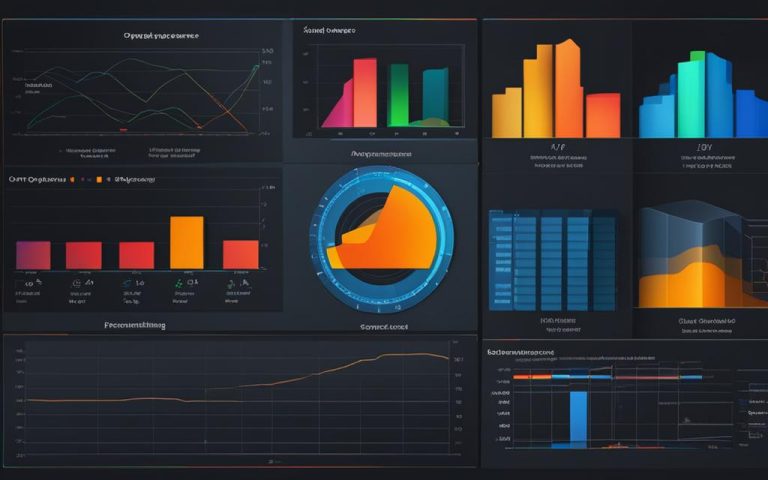Cloud automation is transforming the way businesses manage and operate their cloud-based IT infrastructure. With the advent of specialized software tools and methodologies, organizations can now automate manual tasks, reduce errors, and enhance operational efficiency in their cloud networking operating systems.
In this article, we will delve into the concept of cloud automation, exploring its advantages and disadvantages. We will also highlight the difference between cloud automation and cloud orchestration, discuss popular cloud automation software and tools, and provide best practices for implementing and managing cloud automation.
Cloud automation refers to using software tools and technologies to automate the management and deployment of cloud workloads and resources. By utilizing scripts and automation tools, organizations can streamline repetitive tasks, minimize manual intervention, and improve overall operational efficiency within their cloud networking operating systems.
Benefits of cloud automation include significant cost reduction, scalability, flexibility, enhanced security defenses, increased efficiency and productivity, improved collaboration, and better disaster recovery and resilience. With access to valuable data and insights, organizations can make better-informed decisions.
However, there are considerations to keep in mind, such as safety concerns, the need for reliable network connectivity, and the risk of platform lock-in. It is crucial to assess these factors before implementing cloud automation in cloud networking operating systems.
Cloud automation and cloud orchestration, while related, are distinct concepts. Cloud automation focuses on automating individual tasks, while cloud orchestration involves automating multiple tasks and workflows, including the arrangement and coordination of these processes. Both play critical roles in managing cloud infrastructure, especially in multi-cloud environments.
There is a wide range of cloud automation tools available in the market today. Some popular options include GitHub for source code version control, AWS CloudFormation for infrastructure management, Red Hat Ansible Automation Platform for software deployment, Google Cloud Deployment Manager for cloud automation in Google Cloud, and Azure Automation for cloud automation in Microsoft Azure. These tools enable organizations to automate tasks, optimize workflows, and streamline their cloud operations.
As cloud automation continues to evolve, businesses that embrace it will have a competitive advantage in the ever-changing tech landscape. By leveraging cloud automation, organizations can reduce costs, improve scalability and flexibility, enhance security, increase efficiency and productivity, foster collaboration, ensure better disaster recovery and resilience, and gain valuable data and insights for decision-making.
Stay tuned for the next section, where we will dive deeper into the concept of cloud automation.
Understanding Cloud Automation
Cloud automation is a critical component in the realm of cloud computing, enabling organizations to streamline and optimize their cloud operations. By leveraging software tools and technologies, cloud automation automates the management and deployment of cloud workloads and resources, reducing manual intervention and enhancing operational efficiency.
At its core, cloud automation involves the use of scripts and automation tools to perform repetitive tasks, freeing up valuable time and resources for other strategic initiatives. This not only reduces the risk of human error but also enables organizations to scale their cloud infrastructure with ease.
Cloud automation encompasses various components that work together to deliver a seamless and efficient cloud environment. These components include:
- Orchestration: Coordinating and automating multiple tasks and workflows
- Provisioning: Automatically provisioning and deprovisioning cloud resources
- Monitoring and Management: Monitoring the performance and managing cloud infrastructure
- Integration Capabilities: Integrating cloud services and applications
- Policy-Driven Automation: Enforcing predefined policies for consistent and compliant cloud operations
- Security and Compliance Checks: Automating security and compliance checks to ensure data protection
- Backups and Disaster Recovery Processes: Automating data backups and disaster recovery procedures
By combining these components, organizations can create a robust and efficient cloud automation framework, enabling them to achieve greater agility, cost savings, and operational excellence.
“Cloud automation is a game-changer for organizations looking to leverage the power of cloud computing. By automating manual tasks and streamlining processes, businesses can focus on driving innovation and achieving their strategic goals.”
To illustrate the concept of cloud automation, consider a scenario where an organization wants to deploy a new application on their cloud infrastructure. Without cloud automation, this process would involve manually provisioning servers, configuring network settings, deploying the application code, and managing the associated resources. However, by leveraging cloud automation, organizations can simply define the desired infrastructure as code, and the automation tools will handle the rest, ensuring a consistent and repeatable deployment process.
Cloud automation, when implemented effectively, can bring numerous benefits to organizations. It enables faster time-to-market, reduces costs, improves scalability, enhances security, and allows businesses to focus on their core competencies. As cloud computing continues to evolve, cloud automation will play a pivotal role in enabling organizations to harness the full potential of the cloud.
Pros and Cons of Cloud Automation
Cloud automation offers numerous advantages that contribute to improved operational efficiency and cost savings. Here are the key benefits:
- Cost Reduction: Cloud automation helps businesses optimize resource allocation and reduce unnecessary expenses.
- Scalability and Flexibility: Organizations can easily scale their cloud infrastructure up or down based on demand, ensuring efficient resource utilization.
- Enhanced Security Defenses: Automation enables consistent security policies and controls, helping companies protect their sensitive data and mitigate potential risks.
- Increased Efficiency and Productivity: By automating repetitive tasks, employees can focus on higher-value activities, resulting in improved productivity and faster time-to-market.
- Improved Collaboration: Cloud automation facilitates cross-team collaboration and streamlines workflows, enhancing communication and accelerating project delivery.
- Better Disaster Recovery and Resilience: Automated backups and disaster recovery processes ensure data integrity and enable faster system restoration in the event of an outage.
- Access to Data and Insights: Cloud automation provides organizations with real-time data and analytics, empowering them to make informed decisions and drive business growth.
While the benefits of cloud automation are significant, it is crucial to consider potential disadvantages:
- Safety Concerns: Automating critical tasks may introduce vulnerabilities if not implemented properly, exposing organizations to potential security breaches.
- Reliable Network Connectivity: Cloud automation heavily relies on stable and fast network connections, making organizations vulnerable to disruptions in case of network failures.
- Platform Lock-In: Adopting specific cloud automation tools or platforms may limit the ability to switch providers easily, reducing flexibility and potentially increasing costs in the long run.
Organizations considering cloud automation must carefully weigh these advantages and disadvantages to make informed decisions that align with their specific business needs and goals.

With the growing complexity and demands of Cloud Networking Operating Systems, automation brings significant advantages and some inherent challenges. Let’s take a closer look at these in the following table:
| Advantages of Cloud Automation | Disadvantages of Cloud Automation |
|---|---|
| Cost reduction | Safety concerns |
| Scalability and flexibility | Reliable network connectivity |
| Enhanced security defenses | Platform lock-in |
| Increased efficiency and productivity | |
| Improved collaboration | |
| Better disaster recovery and resilience | |
| Access to data and insights |
Understanding the Difference between Cloud Automation and Cloud Orchestration
Cloud automation and cloud orchestration are two distinct concepts often used interchangeably in the context of managing cloud infrastructure. While both aim to streamline operations and increase efficiency, they entail different scopes and functionalities.
Cloud Automation primarily focuses on automating individual tasks within the cloud environment. It leverages software tools and scripts to replace manual interventions, resulting in improved speed, accuracy, and productivity. Automation is particularly beneficial for repetitive or time-consuming tasks, such as provisioning virtual machines or configuring network settings.
Cloud Orchestration, on the other hand, encompasses a broader scope by automating multiple tasks and workflows across various cloud resources. It involves orchestrating and coordinating these automated processes to enable seamless integration and synchronization. For instance, orchestration may include automating the deployment of web applications, scaling resources based on workload demand, and managing complex cloud infrastructure configurations.
| Cloud Automation | Cloud Orchestration |
|---|---|
| Suited for automating individual tasks | Enables automation of multiple tasks and workflows |
| Focuses on specific actions within the cloud environment | Coordinates and integrates automated processes across multiple resources |
| Achieves improved speed, accuracy, and efficiency for individual tasks | Facilitates seamless integration and synchronization of automated processes |
| Examples: Provisioning virtual machines, configuring network settings | Examples: Deploying web applications, scaling resources based on demand |
In summary, while cloud automation targets individual tasks, cloud orchestration encompasses the automation and coordination of multiple tasks and workflows across various cloud resources. Both are crucial components for managing cloud infrastructure effectively, especially in complex multi-cloud environments.
Overview of Cloud Automation Software and Tools
Cloud automation software and tools play a crucial role in enabling organizations to optimize their cloud operations, automate tasks, and streamline workflows. In this section, we will explore some of the top cloud automation tools available in the market today.
GitHub
GitHub is widely recognized as a leading platform for source code version control. While primarily known for its code hosting capabilities, GitHub also offers robust automation features. It allows teams to collaborate seamlessly, automate software releases, and deploy applications efficiently.
AWS CloudFormation
AWS CloudFormation is a comprehensive infrastructure management tool provided by Amazon Web Services (AWS). It enables users to create, manage, and provision cloud resources in an automated and systematic manner. With CloudFormation, organizations can define their infrastructure as code and effortlessly deploy resources across AWS services.
Red Hat Ansible Automation Platform
Ansible, a popular open-source automation framework, offers the Red Hat Ansible Automation Platform for cloud automation. This platform simplifies software deployment, configuration management, and orchestration across a wide range of cloud environments. It provides a user-friendly interface, extensive library of pre-built automation modules, and robust security features.
Google Cloud Deployment Manager
Google Cloud Deployment Manager is a powerful tool for automating cloud infrastructure management in the Google Cloud environment. It offers declarative templates that enable users to describe and deploy all the necessary resources for their applications. With Deployment Manager, organizations can automate the provisioning, configuration, and deployment of complex cloud architectures.
Azure Automation
Microsoft Azure provides Azure Automation as a cloud automation solution. It offers a wide array of features and capabilities, including job scheduling, process automation, and configuration management. Azure Automation integrates seamlessly with other Azure services, making it an ideal choice for organizations leveraging the Microsoft Azure cloud platform.
These cloud automation tools empower businesses to automate repetitive tasks, optimize workflows, and enhance operational efficiency. The choice of tool may depend on specific requirements, cloud provider preferences, and the complexity of the automation workflows.
Table: Comparison of Top Cloud Automation Tools
| Cloud Automation Tools | Key Features |
|---|---|
| GitHub | Source code version control, collaboration, and software deployment automation |
| AWS CloudFormation | Infrastructure management, resource provisioning, and infrastructure as code |
| Red Hat Ansible Automation Platform | Software deployment, configuration management, orchestration, and extensive library of automation modules |
| Google Cloud Deployment Manager | Cloud infrastructure automation, declarative templates, and automated resource provisioning |
| Azure Automation | Job scheduling, process automation, configuration management, and integration with Azure services |
Embracing the Future of Cloud Automation
Cloud automation is revolutionizing the way businesses operate and manage their cloud infrastructure. By embracing cloud automation, organizations can enjoy a plethora of benefits. One of the key advantages is cost reduction. Automation eliminates the need for manual intervention in repetitive tasks, leading to significant savings in time and resources.
Moreover, cloud automation enables organizations to improve scalability and flexibility. With automated processes in place, businesses can quickly and easily scale their cloud resources up or down as per their requirements, ensuring optimal utilization and cost-effectiveness.
Another crucial aspect that cloud automation addresses is security. By automating security checks and compliance processes, organizations can strengthen their defense against cyber threats and ensure a robust security posture. Furthermore, cloud automation enhances efficiency and productivity by streamlining workflows, reducing errors, and freeing up resources for more strategic initiatives.
Looking towards the future, cloud automation is set to continue its growth and development. Emerging trends in this domain include the integration of artificial intelligence and machine learning capabilities, enabling organizations to leverage advanced analytics for data-driven decision-making. Additionally, the adoption of serverless computing and containerization technologies will further enhance the efficiency and agility of cloud automation.
As the technology continues to evolve, businesses that capitalize on cloud automation will gain a competitive advantage in the dynamic tech landscape. Embracing cloud automation not only provides immediate benefits such as cost reduction, scalability, and security enhancements, but also positions organizations for future success by enabling them to innovate and stay ahead of the curve. In the ever-changing digital era, cloud automation is indeed the way forward for businesses seeking to optimize their cloud infrastructure and drive efficiency in their operations.
FAQ
What is cloud automation?
Cloud automation refers to using software tools and technologies to automate the management and deployment of cloud workloads and resources. It involves using scripts and automation tools to perform repetitive tasks, reducing manual intervention and improving operational efficiency.
What are the benefits of cloud automation?
The benefits of cloud automation include cost reduction, scalability, flexibility, enhanced security defenses, increased efficiency and productivity, improved collaboration, better disaster recovery and resilience, and access to data and insights for better decision-making.
What is the difference between cloud automation and cloud orchestration?
Cloud automation refers to automating a single task, while cloud orchestration involves automating multiple tasks and workflows. Cloud orchestration also includes the arrangement and coordination of automated processes.
What are some popular cloud automation tools?
Some popular cloud automation tools include GitHub for source code version control, AWS CloudFormation for infrastructure management, Red Hat Ansible Automation Platform for software deployment, Google Cloud Deployment Manager for cloud automation in Google Cloud, and Azure Automation for cloud automation in Microsoft Azure.
How does cloud automation benefit businesses?
Cloud automation enables businesses to reduce costs, improve scalability and flexibility, enhance security, increase efficiency and productivity, foster collaboration, ensure better disaster recovery and resilience, and gain valuable data and insights for decision-making.
What is the future of cloud automation?
As the technology continues to evolve, cloud automation will continue to transform the way businesses operate and manage their cloud infrastructure. Businesses that embrace cloud automation will have a competitive advantage in the ever-changing tech landscape.



















